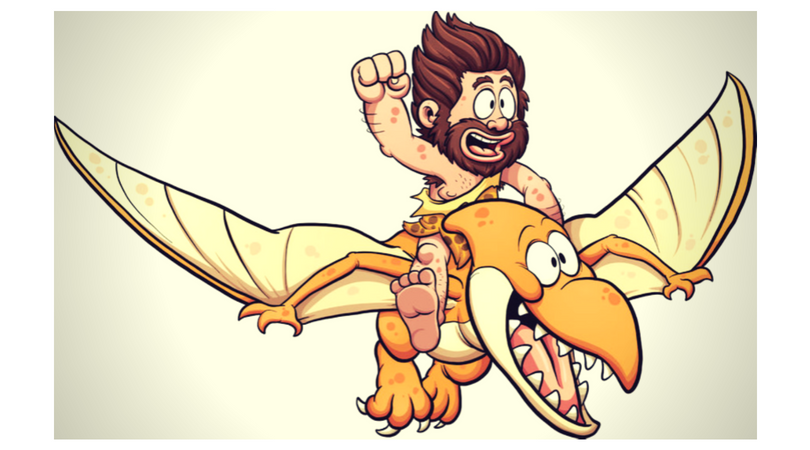
Overcome Anxiety with the Caveman Anxiety Cure

If you want to understand how to overcome anxiety, keep reading . . .
For cave people, anxiety was a good thing.
Not anxiety, exactly. More like the fight-flight-or-freeze response.
Here’s why it was a plus: Let’s say you were cave person who had been chased by a woolly mammoth. This beast wanted to kill and eat you. Fortunately, you managed to outrun him and get back to your cave unscathed. Nonetheless it was a terrifying experience.
Your brain, unbeknownst to you, has a job to do in a situation like this. This job is to keep you from life-threatening situations in the future. It takes note of everything you’ve experienced during this encounter. Then it tucks that information away for future reference. If you’re ever exposed to the possibility of a run-in with Old Woolly again, it employs certain measures to keep you safe.
I’m not just talking about the obvious conscious measures, like you remembering not to go to that part of the meadow ever again.
Click Here to Schedule Your FREE Consultation
It’s more than that. Your mind uses material you don’t even know it has.
According to researchers at the University of Pennsylvania and Princeton University, our brain receives 10 million bits of information per second from just our eyes. We actually “see” a whole lot more than we are aware that we see.
And in a talk entitled Rewire and Evolve Your Brain, Dr. Joe Dispenza says that, overall, the brain processes “ . . . 400 billion bits of information every second. But we are only aware of about 2000.” We are therefore only consciously aware of half a billionth of a percent of what our brain takes in and computes.
That’s a lot of data to use.
Let’s say you were attacked near the mammoth’s habitat, which contained yellow grass. Even if you were too busy fleeing to consciously notice that grass, your brain would pick it up.
Your mind would then associate yellow grass with a woolly mammoth attack.
Its first line of defense to protect you would be to give you a fight-flight-or-freeze response any time you would encounter yellow grass.
Well, not just yellow grass. You would get the same signal any time your brain became aware of the color yellow. That’s because the brain matches patterns very broadly.
In cave times, this would not be a problem. If you ran into something yellow, it probably would be the grass from the woolly mammoth habitat. Your brain would then appropriately send you fight, flight or freeze symptoms. These are the same symptoms you get when you’re anxious: chest pain, heart palpitations, a revved up metabolism, tensed muscles and fear of impending doom.
Click Here to Schedule Your FREE Consultation
For cave dwellers, this would create one of two results: 1) Due to all the physical and mental symptoms they would experience, they would leave or 2) With their revved up metabolism and tensed muscles, they would be optimally ready to engage in battle if a woolly appeared.
The Main Cause of Anxiety is Cave Brain
Unfortunately, the way our “Cave Brain” ensured our survival back then makes it hard to overcome anxiety for modern human beings.
If cave dwellers developed a fight-flight-or-freeze response to yellow (to protect them from mammoth habitat), they wouldn’t have to worry about going into fight-flight-or-freeze when they saw the lemons and bananas at their local supermarket. Nor would Mammoth Grass Yellow become a popular Sherman-Williams paint color that’s in half the homes and businesses, oops, I mean caverns, of their village.
At worst, the color might appear in a cave painting or two that somebody’s sister-in-law composed the previous winter.
But in modern life, a wider variety of sensory stimulation comes at us non-stop in the physical, mental and emotional realms. Sherman-Williams stores and supermarkets abound. Fight-flight-or-freeze responses—in other words, anxiety symptoms—can be triggered by a gazillion situations that, in reality, aren’t threatening to our safety at all.
Anxiety is Really an Allergy
This is why, when most doctors and therapists think of anxiety as a disorder, they’re wrong.
It’s really just a Pattern Matching Allergy. When you understand this, it’s easier to overcome anxiety. (This is why you begin to feel anxiety symptoms just from hearing or reading the word “anxiety.” One little step that will help you overcome anxiety is to refer to it as a “pattern matching allergy” instead.)
Pattern matching is something we do all the time, consciously and unconsciously. It is an important part of how we learn and make discoveries. You can read these words because you know how to match letter patterns.
We begin to make these matches consciously at a very young age. Sesame Street uses the pattern-matching song, “One of These Things is Not Like the Other” for 2-year-olds because they are at an appropriate age to distinguish which items match and which ones don’t.
Click Here to Schedule Your FREE Consultation
And our unconscious pattern matching starts even younger, as you’ll see in a moment.
An allergy occurs when the immune system treats something harmless, like dust or pollen, as if it were a threat that could harm the body. It creates responses that range from the uncomfortable, as in sneezing, itching, and rashes, to the deadly, such as anaphylactic shock, where the blood pressure drops and airways narrow so breathing becomes difficult, and in some cases, impossible.
Nonetheless, the immune system continues defending against what it mistakenly recognizes as deadly traitors.
Our Cave Brain does almost the exact same thing. When it detects a similarity between a current experience and something that we once found emotionally or physically threatening, it sends fight-flight-or-freeze symptoms. It is extremely talented at creating these associations. But in virtually every case, just as with an allergy, these symptoms have no practical value or meaning, as we are under no threat. Instead, they create unnecessary difficulties in our lives.
Unlike with your immune system, you can teach your Cave Brain that the pattern match it perceives isn’t really putting you in danger and overcome anxiety.
Click Here to Schedule Your Free Consultation
Then, when that same situation arises in the future, it won’t send you anxiety symptoms. Instead, it will feel like an ordinary part of life.
Training Your Cave Brain to Overcome Anxiety
How do you teach your Cave Brain that you’re not being threatened by the situation it thinks is a pattern match?
The answer is simple.
You merely have keep going at whatever it is that triggers your anxiety—while you allow yourself to feel—rather than avoid—whatever anxiety symptoms show up.
If you do that, and safely get through the experience without fighting, fleeing (by giving up or finding something less threatening to do) or freezing, your Cave Brain will realize you are safe and permanently turn off the automatic alarm button for that activity or situation. The result is that you will overcome anxiety, at least for this pattern match.
You may find that you are nervous the next few times you perform the activity that created a fight-flight-or flee response for you, but you won’t actually have the physical response.
It may take a few times to get used to the idea that what you used to make you anxious doesn’t do that any more. What’s left will just be like the ripples in a pond after some rocks have been thrown in it. There’s a little bit of leftover energy that needs to be temporarily released while the watery circles finish their dance.
It can be hard, though, to keep going in the face of dizziness, nausea, chest pain, shortness of breath, or whatever your anxiety symptoms include.
But there’s a secret that makes this technique significantly easier. You start to overcome anxiety by tamping it down just enough to keep going at whatever causes it for you. You may be manageably anxious, but you won’t be overwhelmed. There are dozens of methods to help you do this. They fall into five categories, which I will talk about in a future post—“5 Ways to Feel Safer When Anxiety Shows Up.”
Click Here to Schedule Your Free Consultation

Leave a comment